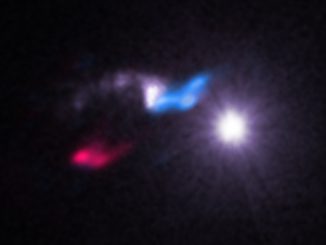
Blinding bursts of X-rays are coming from a supercharged pulsar lying in a galaxy 10 million light years away, more powerful than any pulsar ever seen before. The discovery, by NASA’s Nuclear Spectroscopic Telescope Array, or NuSTAR, challenges what we thought we knew about these extreme objects.
Pulsars are the spinning remnants of stars that have exploded as supernovae. They emit jets of energy from their poles and, as they spin, these jets flash periodically in our direction, making them appear to pulse. Yet none of them are quite as brilliant as a new pulsar uncovered in the Cigar Galaxy, Messier 82, in the constellation of Ursa Major, the Great Bear.
Known as M82 X-2, its discovery was a happy accident. While observing a supernova discovered in Messier 82 in January 2014 by Dr Steve Fossey and his students at University College London, astronomers using NuSTAR noticed something else in the galaxy – a source of X-rays flashing once every 1.37 seconds. NuSTAR recorded the energy of the pulses as being ten times more powerful than the next most luminous pulsar – yet such energies were thought impossible for pulsars. Only black holes, feasting on companion stars, can generate so much energy, but black holes do not pulse.

M82 X-2 is one of many ultra-luminous X-ray sources (ULXs) that have been discovered in other galaxies, although none have yet been found in the Milky Way. The amount of energy they emit, which is on average about 10^32 watts, tallied with the assumption that they are stellar mass black holes radiating X-rays from the gas they accrete. The discovery that at least one is a pulsar is sending scientists back to the drawing board.
“It has all the power of a black hole, but with much less mass,” says Fiona Harrison, NuSTAR’s principal investigator at Caltech. Explaining M82-X2 is difficult; somehow the pulsar is accreting gas at a tremendous rate. “The pulsar appears to be eating the equivalent of a black hole diet,” says Harrison.
NASA’s Chandra X-ray Observatory and Swift telescope have also observed M82-X2, confirming NuSTAR’s results that appear in the 9 October issue of the journal Nature. Now attention is turning back to other ULXs to see whether they also pulse.



